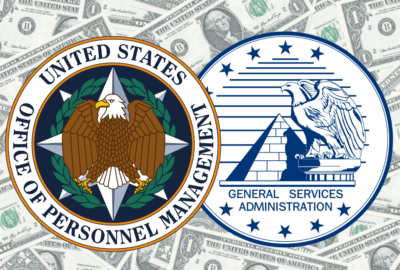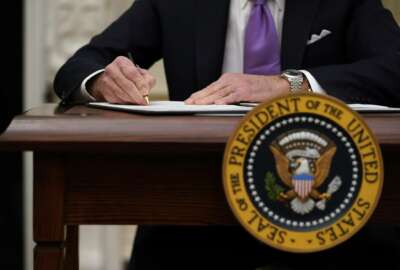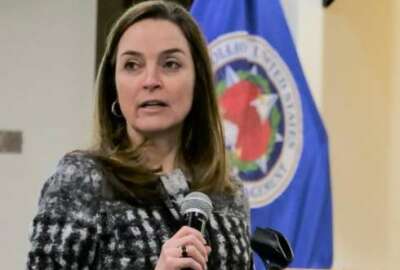
What may survive from Trump’s workforce agenda, with many of the signature policies gone
The Biden administration quickly eliminated many of its predecessors' signature federal workforce policies. With the Schedule Fs and diversity/inclusion training...
Best listening experience is on Chrome, Firefox or Safari. Subscribe to Federal Drive’s daily audio interviews on Apple Podcasts or PodcastOne.
Two weeks into the Biden administration, many of President Donald Trump’s signature workforce changes that stirred up debate and news coverage are gone.
President Joe Biden eliminated them with a few strokes of his pen, all within his first three days in office.
He rescinded the 2018 executive orders that limited collective bargaining, cut official time and emphasized employee discipline and firing.
He did the same with the executive order that canceled certain types of diversity and inclusion training for federal employees and contractors. The order that allowed agencies to reclassify certain career policy jobs to a new class of quasi-political appointees known as Schedule F is gone too.
Like many before it, the Trump administration had ambitious plans to modernize the civil service. It created a new President’s Management Agenda (PMA), which set specific goals aimed at modernizing IT, improving data transparency and building a 21st century federal workforce.
But over time, another agenda emerged.
This agenda challenged the traditions of the decades-old merit system, said Don Kettl, a professor at the University of Texas at Austin’s Lyndon B. Johnson School of Public Affairs. It was the product of the White House Domestic Policy Council, and it ultimately “squeezed out” the strategy set in the PMA, he said.
“This was a management agenda from folks who were trying to make the agencies more productive,” Terry Gerton, president of the National Academy of Public Administration, said of the PMA. “Periodically they got side-swiped by executive orders. But there was attention [on that agenda]. They improved the assessment process through pilot programs for hiring. They really started to address the backlog in security clearances and make that less of an obstacle to get people on board. There were ongoing, persistent activities in the PMA and in the cross-agency priority goals around HR, and that made the HR process better. Then they would kind of get in their own way with the executive orders.”
With many of Trump’s big-ticket, often controversial policies gone, what remains of the previous administration’s workforce agenda?
Experts in the federal community see room for the Biden administration to build on some of the quiet, persistent work agencies have started over the last four years to reskill their workforces, embrace employee engagement initiatives and start a needed conversation about the role of the Office of Personnel Management and the merit system.
Reskilling, workarounds to a lengthy federal hiring process
Reskilling was never a new concept for the federal government, but the Trump administration did attempt to socialize it more broadly to employees.
It created the Cybersecurity Reskilling Academy, which attracted wide interest from federal employees and graduated several dozen people. Few graduates, however, had an easy time finding a new job within the federal government where they could put those skills to good use.
Other agencies launched their own pilots. The Office of Management and Budget created an all-virtual data science reskilling academy.
“The numbers were never large enough to make a dent, and it never really was taken to scale,” Ron Sanders, the staff director for the University of South Florida’s Center for Cybersecurity, said of the administration’s reskilling programs.
The Trump administration also focused on other administrative changes it could make without input from Congress to the federal hiring process.
It launched a pilot program designed to involve subject matter experts in the hiring process. Trump signed an executive order that pushed agencies to use skills-based assessments more frequently.
Sanders served as the chairman of the Federal Salary Council until he resigned last fall over Trump’s Schedule F executive order. He described the reskilling pilots and hiring order as “incremental changes,” ones that were often symbolic or reiterated messages agency HR experts already knew.
“There’s the big stuff and the little stuff,” Sanders said. “The incremental changes is about what we got from the Trump administration … and its predecessor. My hope is the Biden administration will do something grander.”
A different approach to employee engagement
Agencies have long used the Federal Employee Viewpoint Survey to measure the engagement of their workforces for years, but for the first time, the Trump administration set specific, quantifiable goals aimed at improving the lowest performing organizations by 20% by 2020.
It’s unclear whether many low-performing agencies actually met that specific goal over the last few years. But in its work with several agencies on the topic, NAPA saw agencies approach employee engagement with more urgency than perhaps they had previously.
The goal forced agencies to put some extra work into engaging their employees and then institutionalize and embed some of those practices into their organizational cultures, Gerton said.
A few agencies, including the Transportation Security Agency and the Department of Veterans Affairs, examined engagement and customer service data in search of meaningful correlations.
“Way below the surface of the controversial wavetops, there’s been a persistent focus on [engagement] and improving it,” Gerton said. “Agencies are really starting to get committed to the idea that somebody has to be in the bottom 20%, but it’s not going to be us.”
OPM-GSA merger sets the stage for further debate
The prospect of the proposed merger of the Office of Personnel Management with the General Services Administration hung over the Trump administration for more than half of Trump’s tenure, creating uncertainty for the agency and its employees and forcing some long-time executives to retire or leave.
The Trump administration, facing bipartisan criticism and a lack of interest from Congress, formally shelved the merger proposal late last fall.
Sanders said the proposal was a distraction and left little room for OPM to focus on civil service modernization efforts, which the administration initially expressed interest in tackling. Trump’s first permanent OPM director had an ambitious agenda aimed at overhauling everything from federal retirement to veterans preference, but the administration fired him after a few months when he expressed resistance to the proposed merger.
“Reorganizing OPM was a diversion. It took a lot of time, effort and attention. It got lots of people wringing their hands, as it should have,” Sanders said. “The merger sidetracked a lot of people from the big stuff.”
Despite the distraction, others are hopeful the merger illustrated how complex an organization OPM is — and perhaps forced a greater understanding among lawmakers of the agency’s long-simmering challenges.
“What the conflict pointed out was that OPM had been unattended to for a long time, and consequently it didn’t seem that important until you tried to take it apart,” Gerton said. “Now we have the opportunity to think about how to structure it and position it as a strategic asset for the future.”
NAPA is currently reviewing OPM and its statutory functions, per a congressional mandate. The academy is expected to submit a series of recommendations to Congress next month.
“It’ll be really interesting and hopefully start a number of conversations to think through where ultimately this organization can be the most impactful and settle on what the role of OPM should be,” said Brenna Isman, NAPA’s director of academy studies.
Gerton sees the question of OPM and its mission, function and organization as crucial for the Biden administration’s success. The new administration has an extensive list of priorities, including a health and economic crisis to respond to.
“If it doesn’t have an effective civilian workforce it’s not going to be as productive in addressing those challenges as it might otherwise be,” she said. “Having an OPM and a civil service and the rules around it that are functional and that promote this strategic approach to getting the best and brightest into the federal government is going to be really important going forward.”
Though Schedule F and the OPM-GSA merger may have fallen by the wayside, Kettl said the conversations those policies ignited may be worth having in the new administration.
“It would be tempting for the new administration to put these issues aside because it has its hands full with COVID — and because, having taken Schedule F away, they might be tempted to declare victory, at least for a while,” he said. “But without bringing the leadership of the federal workforce back in sync with national priorities, it’s going to be tough for the Biden team to accomplish what it wants to accomplish. The workforce isn’t one more thing to be done — it’s the way to do everything.”
Copyright © 2025 Federal News Network. All rights reserved. This website is not intended for users located within the European Economic Area.
Nicole Ogrysko is a reporter for Federal News Network focusing on the federal workforce and federal pay and benefits.
Follow @nogryskoWFED
Related Stories






